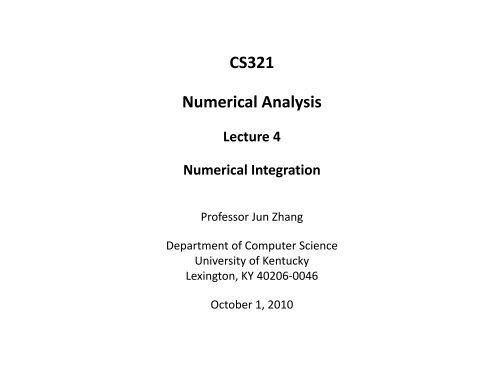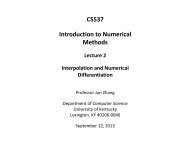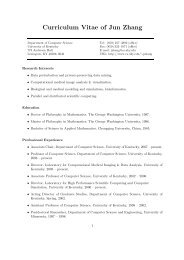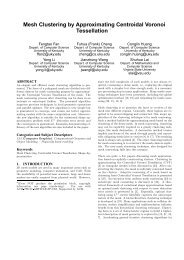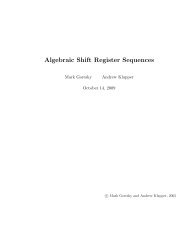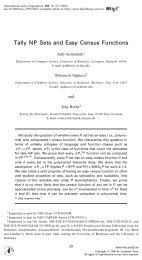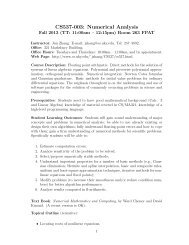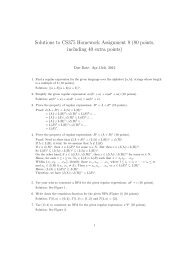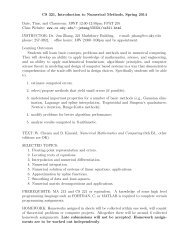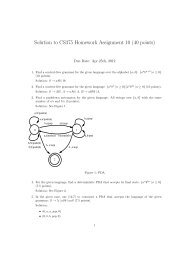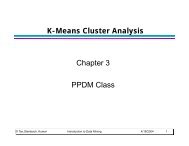Lecture 4 - Computer Science Department - University of Kentucky
Lecture 4 - Computer Science Department - University of Kentucky
Lecture 4 - Computer Science Department - University of Kentucky
You also want an ePaper? Increase the reach of your titles
YUMPU automatically turns print PDFs into web optimized ePapers that Google loves.
CS321<br />
Numerical Analysis<br />
<strong>Lecture</strong> 4<br />
Numerical Integration<br />
Pr<strong>of</strong>essor Jun Zhang<br />
<strong>Department</strong> <strong>of</strong> <strong>Computer</strong> <strong>Science</strong><br />
<strong>University</strong> <strong>of</strong> <strong>Kentucky</strong><br />
Lexington, KY 40206‐0046<br />
October 1, 2010
Definite Integral<br />
A definite integral has an interval for integration. For a fixed integration<br />
interval, the result is a number<br />
π<br />
2<br />
∫ sin x dx = 1<br />
0<br />
An indefinite integral does not have an integration interval. The result<br />
<strong>of</strong> an indefinite integral (antiderivative) is a class <strong>of</strong> functions<br />
∫<br />
sin x dx = − cos x + C<br />
Numerical integration is for computing definite integrals<br />
Fundamental Theorem <strong>of</strong> Calculus:<br />
∫<br />
b<br />
a<br />
x<br />
∫ a<br />
F'(<br />
t<br />
) dt = F<br />
( x<br />
) − F<br />
( a<br />
)<br />
a<br />
F'(<br />
x)<br />
dx = F(<br />
b)<br />
− F(<br />
a)<br />
2
Numerical Integration
Partition<br />
The definite integral <strong>of</strong> a function can be viewed as the area under a<br />
curve. This point <strong>of</strong> view lends us means to compute dfii definite integral<br />
Let P be a partition <strong>of</strong> the interval <strong>of</strong> [a,b] as<br />
P<br />
{ a = x < x < x < < x < x b}<br />
= 0 1 2 L n −1 n =<br />
We have n subintervals as [x i ,x i+1 ]. Let m i be the greatest lower bound <strong>of</strong><br />
(a nonnegative function) f(x) on [x i ,x i+1 ] as<br />
m<br />
i<br />
{ f ( x)<br />
: x ≤ x ≤ x }<br />
= i<br />
inf i<br />
+<br />
and M i as the least upper bound on the same subinterval<br />
M<br />
i<br />
{ f ( x)<br />
: x ≤ x ≤ x }<br />
= i<br />
sup i<br />
+<br />
1<br />
1<br />
4
Partition
Lower and Upper Sums<br />
The lower sums and upper sums <strong>of</strong> f corresponding to the given partition<br />
P is<br />
n−11<br />
L(<br />
f ; P)<br />
= m x − x<br />
U<br />
(<br />
f<br />
;<br />
P<br />
) =<br />
∑<br />
i=<br />
0<br />
n−1<br />
∑<br />
=<br />
i=<br />
0<br />
i<br />
M<br />
( )<br />
i+<br />
1<br />
( x<br />
x<br />
)<br />
i+ 1 −<br />
If we consider the definite integral <strong>of</strong> a nonnegative f as the area under<br />
the curve, we have<br />
L ( f ; P)<br />
f ( x)<br />
dx ≤ U(<br />
f ; P)<br />
for all partitions P<br />
∫<br />
≤ b a<br />
i<br />
i<br />
i<br />
If f is continuous on [a,b], then the above inequality defines the definite<br />
integral. The integral also exists it if f is monotone (ith (either increasing i or<br />
decreasing) on [a,b]<br />
6
Upper and Lower Bounds
Riemann‐Integrable Functions<br />
If the greatest lower bound equals the least upper bound for all partitions <strong>of</strong><br />
[a,b], i.e.,<br />
inf U(<br />
f ; P)<br />
= sup L(<br />
f , P)<br />
Then f is said to be Riemann‐integrable<br />
P<br />
Every continuous function defined on a closed and bounded interval <strong>of</strong> the<br />
real line is Riemann‐integrable<br />
We have<br />
lim<br />
n→∞<br />
L(<br />
f ; P<br />
n<br />
)<br />
= ∫<br />
b<br />
a<br />
P<br />
f ( x)<br />
dx =<br />
lim U(<br />
f ; P<br />
n→∞<br />
where P 0 , P 1 ,.., P n ,… are a sequence <strong>of</strong> partitions such that the length <strong>of</strong> the<br />
largest subinterval in P n converges to 0 as n → ∞<br />
We can construct nested (refined) partitions<br />
n<br />
)<br />
8
Computation<br />
1.) need a procedure to evaluate f(x)<br />
2.) determine a partition (how many subintervals) <strong>of</strong> the interval [a,b]<br />
3.) compute m i and M i on each subinterval<br />
4.) compute the sums L(f; P) and U(f; P)<br />
5.) an approximate value is obtained<br />
b<br />
a<br />
[ U( f ; P) L( f P)<br />
]<br />
1<br />
∫ f ( x)<br />
dx ≈ + ;<br />
2<br />
6.) the error <strong>of</strong> this approximation is bounded by<br />
[ U ( f<br />
;<br />
P<br />
) L<br />
( f<br />
;<br />
P<br />
)<br />
]<br />
1<br />
−<br />
2<br />
9
Trapezoid Rule<br />
A strategy that is better than estimating both the upper and the lower<br />
bounds <strong>of</strong> the area beneath the curve is to use trapezoids<br />
The interval [a,b] is first divided into subintervals [x i ,x i+1 ], 0 ≤ i ≤ n –1. A<br />
typical trapezoid has the subinterval [x i,x i+1 1] as its base, and the two<br />
vertical sides are f(x i ) and f(x i+1 ). The area is given by the base times the<br />
average height. The basic trapezoid rule for the subinterval [x i ,x i+1 ] is<br />
x i<br />
[ f (x ) + f (x )<br />
](x<br />
− x )<br />
∫ + 1<br />
f (x) dx ≈ 1<br />
i i+<br />
1 i+<br />
x<br />
2<br />
1<br />
i<br />
The total area under the curve is<br />
b<br />
∫ f ( x)<br />
dx ≈ T(<br />
f ; P)<br />
= ∑ − a<br />
i=<br />
n<br />
1<br />
A i<br />
0<br />
i<br />
=<br />
−1<br />
1<br />
1 n ∑ ( xi+<br />
1 − xi<br />
)[ f ( xi<br />
) + f ( xi+<br />
1)]<br />
2 i=<br />
0<br />
10
Trapezoid Rule
Uniform Spacing<br />
The lengths <strong>of</strong> the subintervals in a partition can be different. For fast<br />
computation, a uniform partition <strong>of</strong> the interval may be advantageous<br />
Let n be the number <strong>of</strong> subintervals, then h = (b – a)/n is the uniform<br />
interval spacing. The nodal points are x i = a + i h, i = 0, 1,…, n. Hence<br />
the composite trapezoid rule is<br />
n<br />
∑ − 1<br />
h<br />
T(<br />
f ; P)<br />
= [ f ( xi ) + f ( x + 1<br />
2<br />
)] i<br />
2 i=0 0<br />
Note that the end point <strong>of</strong> an interval is the starting point <strong>of</strong> the next<br />
interval. This fact can save almost half <strong>of</strong> the computation,<br />
∫<br />
b<br />
a<br />
f<br />
( x)<br />
dx<br />
≈<br />
⎧<br />
h⎨<br />
⎩<br />
n−1<br />
∑<br />
i=<br />
1<br />
f<br />
( x<br />
) +<br />
1<br />
⎫<br />
[ f ( x0 ) + f ( )] ⎬<br />
2<br />
⎭<br />
i x n<br />
12
Trapezoid Rule with Uniform Spacing
Error Analysis (1)<br />
If f”(x) exists and is continuous on [a,b], the error <strong>of</strong> the composite<br />
trapezoid rule T is<br />
for some ξ in (a,b)<br />
b<br />
b−a<br />
2<br />
2<br />
∫ f ( x)<br />
dx − T = − h f "( ξ ) = O(<br />
h )<br />
12<br />
a<br />
Pro<strong>of</strong>. We first prove the result for a=0, b= 1 and h=1. That is<br />
∫<br />
1<br />
0<br />
[ 1<br />
f<br />
(0) +<br />
f<br />
(1) ] = −<br />
f "(<br />
ξ<br />
)<br />
f ( x<br />
)<br />
dx −<br />
1<br />
2<br />
+<br />
12<br />
This simplified formula will be proved with the help <strong>of</strong> polynomial<br />
interpolation<br />
Define a polynomial <strong>of</strong> degree one that interpolates f at 0 and 1<br />
p ( x<br />
)<br />
=<br />
f<br />
(0)<br />
+<br />
[<br />
f<br />
(1) −<br />
f<br />
(0<br />
)]<br />
x<br />
14
Error Analysis (2)<br />
It follows that<br />
∫<br />
1<br />
0<br />
p(<br />
x)<br />
dx<br />
=<br />
=<br />
f (0) +<br />
1<br />
2<br />
1<br />
[<br />
2<br />
[ f (0) + f<br />
f (1) −<br />
(1)]<br />
f<br />
(0)]<br />
Using the error formula for the polynomial interpolation, we have<br />
Integrate it on both sides,<br />
∫<br />
1<br />
0<br />
f(x)<br />
− p(x)<br />
=<br />
1 f"[<br />
(x)]x(x<br />
( −<br />
2<br />
ξ 1<br />
)<br />
2<br />
1<br />
1 1<br />
f ( x)<br />
dx −∫<br />
p(<br />
x)<br />
dx = ∫ f "[ ξ(<br />
x)]<br />
x(<br />
x −1)<br />
dx<br />
0<br />
2<br />
0<br />
15
Error Analysis (3)<br />
Using the Mean‐Value Theorem for Integrals<br />
So we have<br />
∫<br />
1<br />
0<br />
∫<br />
1<br />
f "[ ξ ( x)]<br />
x(<br />
x −1)<br />
dx =<br />
f "[ ξ ( s)]<br />
0 0<br />
f ( x)<br />
dx −<br />
1<br />
2<br />
[<br />
f<br />
(0)<br />
+<br />
= −<br />
We then do a change <strong>of</strong> variable, and let<br />
f<br />
1<br />
6<br />
(1)]<br />
∫<br />
1<br />
f "( ζ )<br />
=<br />
x(<br />
x −1)<br />
dx<br />
−<br />
1<br />
12<br />
f "( ζ )<br />
g( t)<br />
= f [ a + t(<br />
b − a)],<br />
x = a + ( b − a)<br />
t<br />
dx<br />
= ( b<br />
− a)<br />
dt,<br />
g'(<br />
t)<br />
'[ a<br />
g"(<br />
t<br />
) =<br />
f<br />
"[ a<br />
+<br />
t<br />
(<br />
b − a<br />
)](<br />
b − a<br />
)<br />
=<br />
f<br />
+ t(<br />
b<br />
2<br />
− a)](<br />
b<br />
−<br />
a)<br />
16
Error Analysis (4)<br />
Then using the result for the special case,<br />
∫<br />
a<br />
b 1<br />
f (x)dx<br />
=<br />
(b −<br />
a)<br />
= (b − a)<br />
=<br />
∫<br />
∫<br />
1<br />
0<br />
0<br />
f[a<br />
+<br />
t(b −<br />
a)]dt<br />
g(t)dt<br />
⎧<br />
1<br />
1<br />
⎫<br />
= (b − a) ⎨ [g( 0)<br />
+ g( 1)]<br />
− g"( ζ ) ⎬<br />
⎩2<br />
12 ⎭<br />
3<br />
b − a<br />
(b − a)<br />
[f (a)<br />
+<br />
f (b)] − f"(<br />
ξ<br />
)<br />
2<br />
12<br />
This is the error formula for the trapezoid rule with only one subinterval.<br />
Let [a,b] be divided into n equal subintervals by points<br />
x<br />
, x1,...,<br />
xn,<br />
with subinterval[<br />
xi<br />
,<br />
xi<br />
1<br />
]<br />
0 +<br />
17
Let h be the interval length<br />
Error Analysis (5)<br />
x i h<br />
∫<br />
+ f<br />
(x)dx =<br />
[f (x<br />
)<br />
+<br />
f (x<br />
x i 2<br />
1<br />
)] −<br />
h<br />
12<br />
=<br />
i i+1<br />
f"(<br />
ξ<br />
)<br />
1 3<br />
Sum over all subintervals to get the composite trapezoid rule<br />
b<br />
−1<br />
x<br />
−1<br />
−1<br />
i<br />
∫ = ∑ ∫<br />
+ 1<br />
f ( x)<br />
dx f ( x)<br />
x = ∑ [ f ( xi<br />
) + f ( xi<br />
+ 1)]<br />
− ∑<br />
a<br />
n<br />
i=<br />
0<br />
x<br />
i<br />
h<br />
2<br />
n<br />
i=<br />
0<br />
3<br />
h<br />
12<br />
n<br />
i=<br />
0<br />
f "( ξ )<br />
i<br />
Note that h=(b-a)/n, we use Intermediate-Value Theorem <strong>of</strong> Continuous<br />
Functions,<br />
3 1<br />
1<br />
h n −<br />
n−<br />
b − a 2 ⎡1<br />
− ∑ f "( ξi<br />
) = − h<br />
12 i<br />
12<br />
⎢ ∑<br />
= 0 ⎣n<br />
i<br />
=<br />
0<br />
⎤<br />
f "( ξi<br />
) ⎥ ⎦<br />
i i ⎦<br />
= −<br />
b − a<br />
12<br />
h<br />
2<br />
f<br />
"( ζ )<br />
18
Example 1<br />
Show that<br />
a<br />
h<br />
∫<br />
+ f ( x)<br />
dx<br />
a<br />
h<br />
2<br />
=<br />
3<br />
h<br />
[ f a)<br />
+ f ( a + h)<br />
] − f "( a)<br />
+ L<br />
(<br />
12<br />
Need to define<br />
F ( t)<br />
f ( x)<br />
= ∫<br />
t a<br />
We can expand F(a+h) using Taylor series<br />
dx<br />
2<br />
3<br />
h h<br />
F<br />
( a+ h<br />
) = F<br />
( a<br />
) + hF'(<br />
a<br />
) + F"(<br />
a<br />
) + F"'(<br />
a<br />
) +L<br />
2 3!<br />
Then by the Fundamental Theorem <strong>of</strong> Calculus, we have F’(t) = f(t).<br />
Note that F(a) = 0, F”(t)=f’(t), F”’(t)=f”(t), and so on.<br />
19
We have<br />
Example 2<br />
+ 2<br />
3<br />
a h<br />
h h<br />
∫ f<br />
( x<br />
) dx = hf<br />
( a<br />
) +<br />
f '(<br />
a<br />
) +<br />
f "(<br />
a<br />
) +L<br />
3!<br />
(1)<br />
a<br />
2<br />
We can also apply the Taylor series directly on f(t) as<br />
2<br />
3<br />
(2)<br />
h h<br />
f<br />
( a<br />
+ h<br />
) =<br />
f<br />
( a<br />
)<br />
+<br />
hf<br />
'( a<br />
)<br />
+<br />
f<br />
"( a<br />
)<br />
+<br />
f<br />
"'( a<br />
)<br />
+L<br />
2 3!<br />
Adding f(a) on both sides <strong>of</strong> (2) and multiplying it by h/2, we obtain<br />
(3)<br />
h<br />
[<br />
2<br />
2<br />
3<br />
h<br />
h<br />
f ( a)<br />
+ f ( a+<br />
h)]<br />
= hf(<br />
a)<br />
+ f '( a)<br />
+ f "( a)<br />
+L<br />
2 4<br />
Subtracting (3) from (1), we finally get<br />
a<br />
∫ + h h<br />
1 3<br />
f ( x)<br />
dx−<br />
[ f ( a)<br />
+ f ( a+<br />
h)]<br />
=− h f"(<br />
a)<br />
+L<br />
a<br />
2<br />
12<br />
20
Estimate Grid Spacing<br />
Example. If the composite trapezoid rule is used to compute<br />
1 2<br />
−<br />
∫ 0<br />
e x<br />
dx<br />
with an error <strong>of</strong> at most 0.5 × 10 -4 , what is the uniform grid spacing h?<br />
From the graph <strong>of</strong> the second derivative (a decreasing function)<br />
f "( x)<br />
= (4x<br />
2 − x<br />
− 2) e<br />
2<br />
We find that<br />
f "(<br />
x)<br />
≤ f "(0) =<br />
2<br />
We need<br />
−<br />
b − a<br />
12<br />
h<br />
2<br />
f "( ξ )<br />
≤<br />
1<br />
6<br />
h<br />
2<br />
<<br />
0.5×<br />
10<br />
−4<br />
It follows that h ≤ 0.01732. The number <strong>of</strong> subintervals is n ≥ [1/h] = 58<br />
21
Recursive Trapezoid Idea<br />
What can we do if the initial partition <strong>of</strong> interval is not fine enough?<br />
22
Recursive Trapezoid Formula<br />
Given a parameter n, dividing [a,b] into 2 n equally spaced subintervals, we<br />
have<br />
n 1<br />
h<br />
T(<br />
f ; P)<br />
= h f ( xi ) + [ f ( x0 ) + f ( x n )]<br />
2<br />
∑ −<br />
i=<br />
1<br />
n<br />
= h∑ − f ( a + i h)<br />
+ [ f ( a)<br />
+ f ( b)<br />
]<br />
i=<br />
1<br />
2<br />
Note that n = 2 n and h = (b – a)/2 n<br />
Note that n 2 and h (b a)/2<br />
R(<br />
n,0)<br />
=<br />
h<br />
n<br />
2<br />
∑ − 1<br />
i=<br />
1<br />
1<br />
f ( a +<br />
h<br />
h<br />
i h)<br />
+<br />
2<br />
[ f ( a)<br />
+ f ( b)<br />
]<br />
Notice that R(n,0) can be viewed as dividing each subinterval <strong>of</strong><br />
R(n –1,0)into two equal sub‐subintervals. If we already computed<br />
R(n –1,0), how can we compute R(n,0) cheaply?<br />
23
Recursive Formula<br />
If R(n –1,0)is available, R(n,0) can be computed as<br />
R(n, 0)<br />
1<br />
= R(n −1,<br />
0)<br />
+ h<br />
2<br />
n−<br />
2<br />
1<br />
∑<br />
For n ≥ 1 using h = (b – a)/2 n . Initial starting value is<br />
−<br />
1<br />
k=<br />
1<br />
f[a + ( 2k<br />
−1)h]<br />
1<br />
R ( 0,<br />
0)<br />
= 2<br />
(b − a)[f (a) + f (b)]<br />
The trick is to only sum the function values at every other grid points<br />
Pro<strong>of</strong>. Note that<br />
R<br />
(<br />
n,0)<br />
=<br />
h<br />
2<br />
n<br />
1<br />
∑<br />
− f<br />
(<br />
a<br />
+<br />
i<br />
h<br />
)<br />
+<br />
C<br />
i=<br />
1<br />
with C = h[f(a) + f(b)]/2 and<br />
R(<br />
n − 1,0) = 2h<br />
−<br />
2<br />
n 1<br />
∑ − 1<br />
f ( a + 2 j h)<br />
+ 2C<br />
j=<br />
1<br />
24
Recursive Formula<br />
Hence, we have<br />
R(<br />
n,0)<br />
−<br />
1<br />
2<br />
R(<br />
n −1,0)<br />
=<br />
h<br />
n<br />
n−11<br />
2 −<br />
1<br />
2 −<br />
1<br />
∑<br />
i=<br />
1<br />
f ( a + ih)<br />
− h<br />
∑<br />
j=<br />
1<br />
f<br />
( a + 2<br />
jh)<br />
=<br />
h<br />
Each term in the first sum that corresponds to an even value <strong>of</strong> l is<br />
cancelled by a term in the second term. The final result has only the odd<br />
values <strong>of</strong> l<br />
2<br />
n−1<br />
∑<br />
k = 1<br />
f [ a + (2k<br />
−1)<br />
h]<br />
We can use the recursive trapezoid formula to compute a sequence <strong>of</strong><br />
approximations to a definite integral using the trapezoid rule, without<br />
recomputing the values at points that have already been computed in the<br />
previous step<br />
25
Two Dimensional Integration<br />
For one dimensional numerical integration on [0,1], using uniform space<br />
h = 1/n<br />
n−1<br />
1 1<br />
⎛ i ⎞<br />
∫<br />
f<br />
(<br />
x<br />
)<br />
dx<br />
≈<br />
[<br />
f<br />
(0)<br />
+<br />
2<br />
∑<br />
f<br />
⎜<br />
⎟ +<br />
f<br />
(1)]<br />
0<br />
2h<br />
⎝ n ⎠<br />
i=<br />
1<br />
n<br />
⎛ i ⎞<br />
= ∑ Ai<br />
f ⎜ ⎟<br />
i= 0<br />
⎝<br />
n<br />
⎠<br />
For two dimensional integration on a unit square<br />
1 1<br />
∫ ∫<br />
0 0<br />
f<br />
(<br />
x<br />
,<br />
y<br />
)<br />
dx<br />
dy ≈<br />
=<br />
≈<br />
1<br />
n<br />
∫ ∑<br />
0<br />
i=<br />
1<br />
n<br />
∑<br />
i<br />
=<br />
0<br />
n<br />
∑<br />
i=<br />
0<br />
= n<br />
A<br />
A<br />
n<br />
A<br />
i<br />
∑∑<br />
i= 0 j=<br />
0<br />
∫<br />
i<br />
1<br />
0<br />
n<br />
∑<br />
i<br />
j=<br />
0<br />
A<br />
⎛ i<br />
f<br />
⎜<br />
,<br />
⎝ n<br />
i<br />
f<br />
⎛ ⎜<br />
⎝<br />
A<br />
A<br />
j<br />
j<br />
i<br />
n<br />
f<br />
f<br />
⎞<br />
y<br />
⎟<br />
dy<br />
⎠<br />
⎞<br />
, y⎟<br />
dy<br />
⎠<br />
⎛<br />
⎜<br />
⎝<br />
⎛<br />
⎜<br />
⎝<br />
i<br />
n<br />
i<br />
n<br />
,<br />
,<br />
j<br />
n<br />
j<br />
n<br />
⎞<br />
⎟<br />
⎠<br />
⎞<br />
⎟<br />
⎠<br />
26
Romberg Algorithm<br />
Recursive composite trapezoid method<br />
For h = 1/2 n and n ≥ 1<br />
1 R ( 0,0) 0)<br />
=<br />
(<br />
b<br />
−<br />
a<br />
)[<br />
f<br />
(<br />
a<br />
)<br />
+<br />
f<br />
(<br />
b<br />
)]<br />
2<br />
n−<br />
1<br />
R(n, 0)<br />
=<br />
2<br />
Using Richardson extrapolation, we can have<br />
2 1 − 1<br />
R(n −1,<br />
0)<br />
+ h ∑f[a<br />
+ ( 2k<br />
−1<br />
2 k=1<br />
R(<br />
i,<br />
j)<br />
= R(<br />
i,<br />
j − 1)<br />
+ −<br />
j<br />
1<br />
j<br />
[ R(<br />
i,<br />
j − 1) − R(<br />
i − 1, −<br />
4 1<br />
For i ≥ j and j ≥ 1. This is the Romberg algorithm, which may yield better<br />
approximate values for larger j<br />
1)]<br />
)h]<br />
27
Deriving Romberg Algorithm<br />
Composite trapezoid rule on 2 n-1 subintervals<br />
∫<br />
b<br />
a<br />
f<br />
( x<br />
)<br />
dx =<br />
R<br />
( n −<br />
1,0)<br />
+ a<br />
h<br />
+ a<br />
h<br />
+ a<br />
h<br />
2<br />
4<br />
6<br />
+ L<br />
with h = (b – a)/2 n-1 and the coefficients a i depend on f but not on h<br />
After one refinement and replacing n –1 with n and h with h/2, we have<br />
b<br />
a<br />
∫ f ( x)<br />
dx<br />
=<br />
1 1<br />
1<br />
R( n,0)<br />
+ a h + a h + a h<br />
4<br />
2<br />
Subtracting the 1 st equation from 4 times the 2 nd equation<br />
where for n ≥ 1<br />
∫<br />
R<br />
a<br />
b<br />
2<br />
16<br />
2<br />
4<br />
4<br />
1<br />
4<br />
4<br />
64<br />
4<br />
6<br />
6<br />
16<br />
6<br />
+ L<br />
4 5<br />
f (x) dx = R(n, 1)<br />
− a h − a h<br />
1<br />
( n,1)<br />
= R(<br />
n,0)<br />
+ [ R(<br />
n,0)<br />
− R(<br />
n −<br />
3<br />
6<br />
6<br />
1,0)]<br />
+L<br />
28
More Romberg Algorithm<br />
We could apply the extrapolation idea repeatedly to get<br />
where<br />
∫<br />
b<br />
a<br />
1 6 21<br />
f ( x)<br />
dx = R(<br />
n,2)<br />
+ a h + a h<br />
4<br />
3<br />
6<br />
4<br />
5<br />
8<br />
8<br />
+L<br />
1<br />
R( n,2)<br />
= R(<br />
n,1)<br />
+<br />
15<br />
[ R(<br />
n,1)<br />
− R(<br />
n −1,1)]<br />
This time, the truncation error is <strong>of</strong> sixth order<br />
A few steps <strong>of</strong> extrapolation may generate very accurate<br />
approximations<br />
Too many extrapolations may make the computation tedious<br />
29
General Extrapolation<br />
Extrapolation processes can be applied in more general cases where the error<br />
term can be represented as<br />
E<br />
=<br />
a<br />
h<br />
α<br />
+ b h<br />
β<br />
+ c h<br />
γ<br />
+ L<br />
with 0 < α < β < γ, we show how the first term <strong>of</strong> the error expansion is<br />
annihilated. Let<br />
α β γ<br />
L = φ( h)<br />
+ a h + b h + c h + L (1)<br />
Replacing h by h/2 yields<br />
h<br />
h α<br />
h β<br />
h γ<br />
L = φ ( ) +<br />
a<br />
( ) +<br />
b<br />
( ) +<br />
c<br />
( ) + L<br />
(2<br />
)<br />
2 2 2 2<br />
Multiplying (2) by 2 α<br />
α<br />
α<br />
h α α h β α h γ<br />
( ) + a h + 2 b ( ) + 2 c ( ) + (3)<br />
2 L = 2 φ<br />
2<br />
2<br />
2<br />
L<br />
30
General Extrapolation – Cont.<br />
Subtracting the previous two equations, we can remove the h α term<br />
α<br />
α<br />
⎛ h⎞<br />
⎞<br />
(2 − 1) L = 2 φ⎜<br />
⎟ − φ(<br />
h)<br />
⎝ 2 ⎠<br />
+ (2<br />
α −β<br />
− 1) b h<br />
β<br />
+ (2<br />
α −γ<br />
We can write the new approximation formula as<br />
α<br />
2 ⎛ h⎞<br />
1<br />
L = φ⎜<br />
⎟ − φ(<br />
h)<br />
+ bh<br />
α<br />
α<br />
2 − 1<br />
⎝<br />
2<br />
⎠<br />
2 −<br />
1<br />
− 1) c h<br />
β<br />
γ<br />
+ ch<br />
+ L<br />
γ<br />
+ L<br />
This approximation formula raises the order <strong>of</strong> truncation error from<br />
O(h α ) to O(h β ) with α < β<br />
Please read the book on p. 217 for a concrete example to show how the<br />
approximation accuracy is improved using extrapolation<br />
31
Basic Simpson’s Rule<br />
Simple trapezoid rule uses two points for approximations<br />
Can we get more accurate approximation using more points?<br />
32
Basic Simpson’s Rule<br />
A three point numerical integration rule using the middle point <strong>of</strong> the<br />
interval is known as the Simpson’s s rule with different weights for each point<br />
a<br />
a<br />
2h<br />
[ f ( a)<br />
+ 4 f ( a + h)<br />
+ f ( a 2h<br />
]<br />
∫ + h<br />
f ( x)<br />
dx ≈<br />
+<br />
3<br />
)<br />
Using Taylor’s expansion, we can find the error term <strong>of</strong> this approximation<br />
is<br />
5<br />
h (4)<br />
− f ( ξ )<br />
90<br />
For some point ξ in (a,a+2h). This should be compared to the error term <strong>of</strong><br />
the simple trapezoid rule O(h 3 )<br />
It is desirable to subdivide the interval adaptively so that refinement is only<br />
placed in the area <strong>of</strong> large fluctuation <strong>of</strong> function value<br />
33
Basic Simpson’s Rule<br />
Comparing composite trapezoid rule and Simpson’s rule<br />
34
Basic Simpson’s Rule<br />
Using Taylor series for f(x) at a, we have<br />
1 2<br />
1 3<br />
1 4 (4)<br />
f(<br />
a+ h)<br />
= f(<br />
a)<br />
+ hf'(<br />
a)<br />
+ h f"(<br />
a)<br />
+ h f"'(<br />
a)<br />
+ h f ( a)<br />
+L<br />
2! 3! 4!<br />
If we replace the interval size h by 2h, we obtain<br />
4<br />
2 4<br />
3 2<br />
4<br />
(4)<br />
f<br />
( a+ 2 h<br />
) =<br />
f<br />
( a<br />
) +<br />
2<br />
hf<br />
'( a<br />
) +<br />
2<br />
h<br />
f<br />
"( a<br />
) +<br />
h F<br />
"'( a<br />
) +<br />
h<br />
f<br />
( a<br />
) +L<br />
3 4!<br />
By combining these two expansions, we get<br />
2<br />
3 20 4 (4)<br />
f(<br />
a)<br />
+ 4f(<br />
a+<br />
h)<br />
+ f(<br />
a+<br />
2 h)<br />
= 6f(<br />
a)<br />
+ 6hf'(<br />
a)<br />
+ 4h<br />
f"(<br />
a)<br />
+ 2h<br />
f"'(<br />
a)<br />
+ h f ( a)<br />
+L<br />
4!<br />
35
On the other hand, define<br />
We expand F(a+2h) as<br />
Basic Simpson’s Rule<br />
F (<br />
x<br />
)<br />
= x f<br />
(<br />
t<br />
)<br />
dt<br />
a<br />
∫<br />
5<br />
2 4<br />
3 2<br />
4<br />
(4) 2<br />
5<br />
(5)<br />
F ( a<br />
+ 2 h<br />
) =<br />
F ( a<br />
)<br />
+<br />
2<br />
hF '( a<br />
)<br />
+<br />
2<br />
h F<br />
"( a<br />
)<br />
+<br />
h F<br />
"'( a<br />
)<br />
+<br />
h<br />
f<br />
( a<br />
)<br />
+<br />
h F<br />
( a<br />
)<br />
+L<br />
3 3 5!<br />
Note that F’=f, F(a)=0, F”=f’, F”’=f”, we have<br />
∫ + 5<br />
a 2h<br />
2 4 3 2 4 2 5 (4)<br />
f(<br />
x)<br />
dx=<br />
2hf(<br />
a)<br />
+ 2h<br />
f'(<br />
a)<br />
+ h f"(<br />
a)<br />
+ h f"'(<br />
a)<br />
+ h f ( a)<br />
+L<br />
a<br />
3 3 5⋅4!<br />
From the previous page, we have<br />
h<br />
[ f ( a)<br />
+ 4 f ( a + h)<br />
+ f ( a + 2h)]<br />
=<br />
3<br />
2 4 3<br />
2hf<br />
( a)<br />
+ 2h<br />
f '(<br />
a)<br />
+ h f "( a)<br />
3<br />
+ 2 4 20 5 (4<br />
h f "'(<br />
a)<br />
+ h f<br />
) ( a)<br />
+L<br />
3 3⋅<br />
4!<br />
36
Basic Simpson’s Rule (1)<br />
Subtracting the previous two terms, we have<br />
a<br />
∫ + 2h<br />
a<br />
5<br />
h<br />
h (4)<br />
f ( x)<br />
dx=<br />
[ f ( a)<br />
+ 4f<br />
( a+<br />
h)<br />
+ f ( a+<br />
2h)]<br />
− f −L<br />
3<br />
90<br />
We have the Simpson’s rule as<br />
a<br />
+ 2h<br />
b−a<br />
⎛ a+<br />
b⎞<br />
∫<br />
f ( x ) dx≈<br />
[<br />
f<br />
( a<br />
) + 4<br />
f<br />
⎜<br />
⎟+<br />
f<br />
( b<br />
)]<br />
a<br />
6<br />
⎝ 2<br />
⎠<br />
The error term <strong>of</strong> the Simpson’s rule us<br />
5<br />
1 (4)<br />
⎛b−a⎞<br />
− ⎜ ⎟ 90 ⎝<br />
2<br />
⎠<br />
f<br />
( ξ)<br />
37
Adaptive Simpson’s Algorithm<br />
Reduce the size <strong>of</strong> the intervals to get more accurate approximations<br />
38
Adaptive Simpson’s Algorithm<br />
Given an interval [a,b], we can use the basic Simpson’s rule to compute<br />
an approximation to the integral as<br />
where the approximation part is<br />
I ∫ f ( x)<br />
dx = S(<br />
a,<br />
b)<br />
+ E(<br />
a,<br />
b)<br />
≡ b a<br />
( b − a)<br />
⎡ ⎛ a + b ⎞ ⎤<br />
S( a,<br />
b)<br />
= ⎢ f ( a)<br />
+ 4 f ⎜ ⎟ + f ( b)<br />
6<br />
⎥<br />
⎣ ⎝ 2 ⎠ ⎦<br />
and the error term is<br />
E(<br />
a,<br />
b)<br />
= −<br />
b−a<br />
5 (4)<br />
( ) f ( )<br />
1<br />
ξ<br />
90 2<br />
For simplicity, we assume f (4) (x) remains constant on (a,b). Let h = b – a,<br />
we have<br />
(1) (1)<br />
I = S + E<br />
For the first step approximation with<br />
(1)<br />
S = S(<br />
a,<br />
b)<br />
39
Adaptive Simpson – (II)<br />
And<br />
E<br />
(1)<br />
=<br />
−<br />
1 ⎛ h⎞<br />
⎜<br />
⎟<br />
90<br />
⎝<br />
2<br />
⎠<br />
5<br />
f<br />
(4)<br />
We then subdivide the interval [a,b] and apply the basic Simpson’s rule<br />
on the subintervals [a,c] and [c,b] respectively. We have a new<br />
approximation on [a,b] as the sum <strong>of</strong> two separate approximations<br />
where c = (a + b)/2 with<br />
(2)<br />
(2)<br />
I = S +<br />
S = S(<br />
a,<br />
c)<br />
+<br />
E<br />
(2)<br />
S(<br />
c,<br />
b)<br />
and<br />
5<br />
5<br />
(2) 1 ⎛ h / 2 ⎞ (4) 1 ⎛ h / 2 ⎞ (4) 1 (1)<br />
E = − ⎜ ⎟ f − ⎜ ⎟ f = E<br />
90 ⎝ 2 ⎠ 90 ⎝ 2 ⎠ 16<br />
This is certainly til a better btt approximation since the subintervals are smaller<br />
than the original interval<br />
20
Adaptive Simpson – (III)<br />
Subtracting the two approximations yields<br />
(2)<br />
(1)<br />
(1)<br />
(2)<br />
S −<br />
S<br />
=<br />
E −<br />
E<br />
=<br />
15E<br />
Hence the numerical integration can be<br />
(2)<br />
(2)<br />
(2)<br />
I =<br />
S<br />
+<br />
E =<br />
S<br />
+<br />
(2)<br />
(2)<br />
1<br />
(<br />
S −<br />
S<br />
15<br />
The error term is then computable and can be used for building the<br />
adaptive process<br />
1<br />
(2)<br />
(1)<br />
S − S < ε<br />
15<br />
If this test shows that the error is larger than ε, the interval [a,b] can be<br />
split into two subintervals [a,c] and [c,b] with c = (a + b)/2. The<br />
previously described procedure is replaced by ε/2 to make sure that the<br />
error sum is smaller than ε<br />
(1)<br />
)<br />
41
Adaptive Simpson’s Algorithm<br />
Refine the intervals at the places where the function changes quickly<br />
42
Adaptive Simpson – (IV)<br />
Numerical integration on subintervals<br />
b<br />
c<br />
b<br />
I = ∫ f (x) dx = ∫ f (x) dx + ∫ f (x) dx = IL<br />
+ I<br />
a<br />
(2)<br />
L<br />
a<br />
Let S be thesum<strong>of</strong> S on[<br />
a,c]<br />
and S on[<br />
c,b]<br />
,wehave<br />
I<br />
If we want to have<br />
−<br />
S<br />
=<br />
I<br />
I<br />
L<br />
L<br />
1<br />
15<br />
It is more than enough to have<br />
and<br />
≤<br />
=<br />
S<br />
+<br />
I<br />
−<br />
R<br />
(2)<br />
S L<br />
(2)<br />
L −<br />
−<br />
I<br />
S<br />
− S<br />
c<br />
(2)<br />
R<br />
S<br />
+<br />
(1)<br />
L<br />
(2)<br />
L<br />
I<br />
R<br />
+<br />
≤ ε<br />
−<br />
+<br />
1<br />
15<br />
S<br />
S<br />
1 (2) (1)<br />
S − ≤<br />
ε<br />
15 L S L 2<br />
1 (2)<br />
(1)<br />
S −<br />
≤<br />
ε<br />
15 R S R 2<br />
(2)<br />
R<br />
(2)<br />
R<br />
(2)<br />
R<br />
S<br />
−<br />
S<br />
(1)<br />
R<br />
R<br />
43
Adaptive Simpson’s Algorithm<br />
One decision to make is to choose where to refine the interval<br />
44
Computational Procedure<br />
The interval [a,b] is divided into four subintervals <strong>of</strong> equal length. Two<br />
Simpson approximations are computed using two double‐width subintervals<br />
and four single‐width subintervals<br />
S<br />
S<br />
1<br />
=<br />
h<br />
⎡<br />
⎛ a<br />
+<br />
b<br />
⎞<br />
⎢ f ( a)<br />
+ 4 f<br />
⎜<br />
⎟ +<br />
6 ⎣ ⎝ 2 ⎠<br />
h ⎡<br />
=<br />
12<br />
⎢<br />
⎣<br />
⎤<br />
f ( b)<br />
⎥<br />
⎦<br />
⎛ a + c ⎞<br />
⎛ c + b ⎞<br />
f<br />
( a<br />
) + 4<br />
f<br />
⎜<br />
⎟ + 2<br />
f<br />
( c<br />
) + 4<br />
f<br />
⎜<br />
⎟ +<br />
⎝<br />
2<br />
⎠<br />
⎝<br />
2<br />
⎠<br />
2 f<br />
⎤<br />
( b<br />
)<br />
⎥<br />
⎦<br />
If |S 2 -S 1 | ≤15ε, we have done, and set<br />
1<br />
S =<br />
[ 16<br />
S2<br />
−<br />
S1<br />
]<br />
15<br />
Otherwise the interval [a,b] is divided in half and the recursive procedure is<br />
applied on the two subintervals [a,c] and [c,b], until either the error tolerance<br />
is satisfied or the maximum number <strong>of</strong> subdivisions is reached<br />
45
Adaptive Simpson’s Algorithm<br />
Which sub‐interval or both to divide for refinement<br />
46
Gaussian Quadrature Formulas<br />
A general numerical integration formula is<br />
∫<br />
b<br />
a<br />
f x<br />
) dx ≈ A<br />
f<br />
( x<br />
) + A<br />
f<br />
( x<br />
) + L+<br />
( 0 0<br />
1<br />
1 A<br />
n<br />
f<br />
( x<br />
n<br />
It suffices to know the nodes x 0 , x 1 ,…, x n and the weights A 0 , A 1 ,…, A n .<br />
For important special functions, they are listed in some reference books<br />
Suppose a set <strong>of</strong> nodes is given, how to find the weights. This can be<br />
done using Lagrange interpolation polynomial as<br />
n<br />
p(<br />
x)<br />
= f ( x ) l ( x)<br />
With<br />
l<br />
(<br />
x<br />
)<br />
i<br />
=<br />
∑<br />
i=<br />
0<br />
n<br />
∏<br />
j=<br />
o,<br />
j≠1<br />
⎛<br />
⎜<br />
⎝<br />
i<br />
i<br />
i<br />
x −<br />
x − x<br />
x i<br />
j<br />
⎟⎞<br />
⎟<br />
⎠<br />
)<br />
If p is a good approximate to f, we anticipate<br />
approximate to ∫ b f ( x<br />
) dx<br />
a<br />
∫ b a<br />
p ( x)<br />
dx<br />
is a good<br />
47
We integrate over p(x) as<br />
∫<br />
b<br />
a<br />
f ( x<br />
)<br />
dx ∫ p<br />
( x<br />
)<br />
dx<br />
where we can compute<br />
Gaussian Quadrature<br />
b<br />
≈ ∫ a<br />
n<br />
n<br />
b<br />
= ∑ f ( xi<br />
) ∫ l =<br />
a i ( x)<br />
dx ∑<br />
i=<br />
0<br />
i=<br />
1<br />
i<br />
∫<br />
= b l<br />
a i<br />
A ( x)<br />
dx<br />
A<br />
i<br />
f ( x<br />
Note that the polynomial interpolation is exact for a polynomial <strong>of</strong><br />
degree at most n. It follows that the integration will be exact for such<br />
polynomials<br />
If the nodes can be chosen carefully, it is possible to increase the order<br />
<strong>of</strong> polynomial with the exact integration remarkably. This was<br />
discussed by Karl Gauss<br />
i<br />
)<br />
48
An Example<br />
Determine a quadrature formula when the interval is [‐2,2] and the<br />
nodes are ‐1, 0, and 1.<br />
We first need to compute the cardinal functions<br />
2 ⎛ x − x ⎞<br />
j 0 1 1<br />
( ) ⎜ ⎟<br />
⎛ x − ⎞⎛<br />
x − ⎞<br />
l0 x = ∏ = ⎜ ⎟⎜ ⎟ = x(<br />
x −1)<br />
j<br />
=<br />
1 ⎝ x<br />
0<br />
− x<br />
j<br />
⎠<br />
⎝<br />
( −1)<br />
− 0<br />
⎠⎝<br />
−1−1<br />
⎠ 2<br />
2 ⎛ x − x ⎞<br />
j ⎛ x + 1 ⎞⎛<br />
x −1⎞<br />
1 2<br />
l ( x)<br />
= ∏⎜<br />
⎟ = ⎜ ⎟ ⎟ = − x<br />
1 ⎜<br />
j 1 x1<br />
x<br />
= ⎝ −<br />
j ⎠ ⎝ 0 − ( −1)<br />
⎠⎝<br />
0 −1⎠<br />
2 ⎛ x − x ⎞<br />
1) ⎞<br />
− 0<br />
1<br />
⎛ x − ( −<br />
⎛ x ⎞<br />
2<br />
( ) = ∏ ⎜ j<br />
l x<br />
⎟ =<br />
⎜<br />
⎟<br />
⎜<br />
⎟ = x<br />
( x<br />
+<br />
1)<br />
j=<br />
1 ⎝ x2<br />
− x<br />
j ⎠ ⎝ 1−<br />
( −1)<br />
⎠⎝<br />
1−<br />
0 ⎠ 2<br />
The weights are computed by integrating these functions<br />
A<br />
2<br />
2 1 2<br />
1<br />
⎡1<br />
3 1 2<br />
⎤<br />
= ∫ l ( x)<br />
dx = ( −1)<br />
=<br />
=<br />
0 2 0<br />
2<br />
2<br />
2 ⎢<br />
−<br />
− ∫ x x dx x x<br />
−<br />
⎣3<br />
2 ⎥<br />
⎦ −2<br />
8<br />
3<br />
49
Similarly, we have<br />
A<br />
An Example<br />
2 2<br />
2<br />
2<br />
1<br />
3<br />
( )<br />
(1 )<br />
⎤<br />
1 2 1<br />
2 ⎢<br />
⎡ = ∫ l x dx = − = − =<br />
3 ⎥<br />
⎣ ⎦<br />
−<br />
− ∫ x dx x x<br />
−<br />
−2<br />
2<br />
=<br />
2<br />
2 1 2<br />
1 ⎡1<br />
3 1 2 ⎤<br />
A = ∫ l<br />
( x<br />
) dx =<br />
+ 1) =<br />
x(<br />
x<br />
dx<br />
x + x<br />
2 2 2<br />
2<br />
2<br />
2<br />
⎢<br />
⎣<br />
3<br />
2<br />
⎥ − ∫ −<br />
⎦<br />
So the quadrature formula defined on the interval [‐2,2] and using the<br />
node ‐1, 0, 1, is<br />
2<br />
∫ − 2<br />
8<br />
4<br />
8<br />
f ( x)<br />
dx≈<br />
f ( −1)<br />
− f (0) +<br />
3 3 3<br />
f (1)<br />
It can be verified that this formula gives exact values for the three<br />
functions<br />
2<br />
f ( x)<br />
= 1, x,<br />
x<br />
−2<br />
8<br />
3<br />
4<br />
3<br />
50
Gaussian Quadrature Theorem<br />
Let q be a nontrivial polynomial <strong>of</strong> degree n + 1 such that<br />
∫<br />
b<br />
a<br />
x<br />
k<br />
q( x)<br />
dx = 0 (0 ≤ k ≤ n)<br />
Let x 0 , x 1 ,…, x n be zeroes <strong>of</strong> q. Then we define the formula<br />
b<br />
∑<br />
∫<br />
f<br />
(<br />
x<br />
)<br />
dx ≈<br />
A i<br />
f<br />
(<br />
x i<br />
),<br />
A i<br />
=<br />
∫<br />
l<br />
(<br />
x<br />
)<br />
dx<br />
a<br />
≈ n<br />
i=<br />
0<br />
With these x i ’s as nodes, the approximation will be exact for all<br />
polynomials <strong>of</strong> degree at most 2n+1. All these nodes lie in the open<br />
interval (a,b)<br />
We can first figure out the quadrature for<br />
∫<br />
1<br />
−1<br />
f<br />
( t<br />
)<br />
dt ≈<br />
Then use the transformation t = [2x –(b – a)]/(b – a) for a Gaussian<br />
quadrature on the general interval [a,b]<br />
n<br />
∑<br />
i=<br />
0<br />
A<br />
f<br />
(<br />
i t i<br />
)<br />
b<br />
a i<br />
51
The transformed integral is<br />
∫ a f ( x<br />
) dx<br />
∫ b<br />
=<br />
Gaussian Theorem Pro<strong>of</strong><br />
1<br />
[<br />
1<br />
1<br />
( b − a)<br />
∫ −<br />
f ( b − a)<br />
t + ( b + a ]dt<br />
1 2<br />
1 2<br />
2<br />
)<br />
Pro<strong>of</strong> <strong>of</strong> Gaussian Quadrature Theorem:<br />
Let f be any polynomial <strong>of</strong> degree at most (2n +1) 1). Dividing f by q with<br />
quotient p and a remainder r<br />
f = p q +<br />
Both q and r are <strong>of</strong> degree at most n<br />
r<br />
By hypothesis, we have<br />
∫ b a<br />
Since x i are roots <strong>of</strong> q, we have<br />
q( x)<br />
p(<br />
x)<br />
dx =<br />
f ( xi<br />
) = p(<br />
xi<br />
) q(<br />
xi<br />
) + r(<br />
xi<br />
) = r(<br />
xi<br />
)<br />
0<br />
52
Gaussian Theorem Pro<strong>of</strong> (II)<br />
Since the degree <strong>of</strong> r is at most n, the integration<br />
∫ b a<br />
r ( x)<br />
dx<br />
is exact<br />
∫<br />
b<br />
a<br />
f ( x)<br />
dx<br />
=<br />
∫<br />
b<br />
a<br />
=<br />
∫<br />
r<br />
(<br />
x<br />
)<br />
dx<br />
b<br />
a<br />
p(<br />
x)<br />
q(<br />
x)<br />
dx +<br />
=<br />
n<br />
∑<br />
A r<br />
(<br />
x<br />
)<br />
=<br />
∫<br />
b<br />
a<br />
n<br />
∑<br />
i<br />
i<br />
i= 0 i=<br />
0<br />
r(<br />
x)<br />
dx<br />
A<br />
i<br />
f<br />
(<br />
x<br />
Gaussian Quadrature Theorem guarantees high accuracy numerical<br />
integration with just a few nodes. However, finding these nodes is not an<br />
easy task. The roots <strong>of</strong> Legendre polynomials are the nodes for Gaussian<br />
quadrature on the interval [-1,1]. With q 0 (x) = 1, q 1 (x) = x, we have for<br />
n ≥ 2<br />
q<br />
n<br />
⎛ 2n<br />
− 1⎞<br />
⎛ n − 1⎞<br />
( x)<br />
= ⎜ ⎟xqn−1(<br />
x)<br />
− ⎜ ⎟qn−2(<br />
x)<br />
⎝ n ⎠ ⎝ n ⎠<br />
i<br />
)<br />
53


